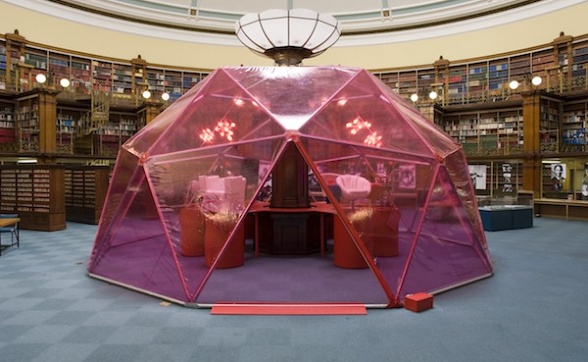Mario Navarro
Mario Navarro, Two Rooms, 2006.
Mario Narvarro (b. 1970, Chile) usually works with his notion of ‘mobile art’: work made out of readily available, light and low-cost materials, easy to transport and display. The ultimate example was Radio Ideal: an amateur radio station in a trailer that drove through Santiago, broadcasting interviews with people, and music composed by artists. The programme varied according to the community in which the trailer temporarily stayed.
A ‘project about radio dissemination as well as a mobile sound sculpture’ (Navarro), it was inspired by the clandestine radio stations broadcasting during the military dictatorship. By creating it after democracy was restored in Chile, the artist was also commenting on the absence of a full renovation in the country. This was also the case with Opala, an environmental installation based on the Opala Chevrolet, built in Brazil and used by the secret services of several South American dictatorships, which became a symbol of terror. The cars have now been recycled as taxis.
All Navarro’s work (video, photography, installation, assemblage, drawing – frequently combined) has been organised as a series called The New Ideal Line. Navarro has also curated exhibitions as part of his artistic research, described by him as a critical statement against ‘a blind, high-speed, one-way modernity’.
Liverpool John Moores University is the home of the Stafford Beer archive. In 1971 Beer was invited by Chile's president Salvador Allende to develop a system to regulate the country's social economy, based on Beer’s ideas of linking biological and man-made systems. The heart of Project Cybersyn was the Operations Room – a futuristic, ergonomically designed meeting space.
For International 06, Navarro recreated the Operations Room in the form of his work Two Rooms (2008). Housed in a geodesic dome, the structure conveyed interconnectedness and efficiency. The dome shape also evoked a cerebrum, reflecting Beer’s belief in the similarities between the brain and management science, and was accentuated by its placement under the domed ceiling of the Picton Reading Room.
Each of the nine chairs inside the Operations Room were ‘modified’ by a Liverpool person with a brain injury, following the specification that each chair should have an arm that holds an ashtray and a glass. As with much of Navarro’s work, Two Rooms dealt with the political situation of Chile and Utopian visions. The intimate and handmade modifications invited by Navarro exposed the idealisation of 1970s’ information design through the reality of the personal with its malfunctions.
Mario Navarro at Liverpool Biennial 2006
Two Rooms, 2006
Mixed media intervention
Commissioned by Liverpool Biennial 2006
Exhibited in Picton Library Reading Room. Aquarelle
Supported by
Northwest Regional Development Agency
Calouste Gulbenkian Foundation
Visiting Arts Central Library, Liverpool
Liverpool Biennial
55 New Bird Street
Liverpool L1 0BW
- T +44 (0)151 709 7444
- info@biennial.com
Liverpool Biennial is funded by
Founding Supporter
James Moores
